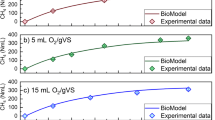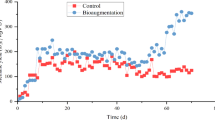Abstract
The effects of liquid recirculation on a liquefaction-acidogenic reactor in an anaerobic two-phase digesting system operating with grass-clover silage was studied during 40 days after initiating recirculation of effluent from the methanogenic reactor to the liquefaction-acidogenic reactor. An increase in alkalinity and, thus, an increase in pH from 5.2 to 6.0 occurred in the liquefaction-acidogenic reactor. During the same period, a 10-fold increase (from 0.2 to 1.9 g·l−1·h−1) in the degradation rate of mannitol and an almost 9-fold increase in the activity of hydrogenotrophic methanogens was observed. The estimated number of these bacteria increased by one order of magnitude. The average degradation rate of lactate increased 3-fold, probably as a consequence of the more efficient hydrogen consumption by the hydrogenotrophic methanogens. An observed increase in net mineralization of organic nitrogen compounds was probably the main reason for an enhanced net production of organic acids (from 0.2 to 0.9 g·l−1·d−1). The liquefaction of cellulose and hemicellulose was low from the start of recirculation (3% and 20% reduction, respectively) and did not seem to be affected by the liquid recirculation. This was in accordance with the low number of cellulose degraders (4.0·102 counts·ml−1) observed. The results from this investigation show that the initiation of liquid recirculation in silage-fed two-phase biogas processes will stimulate the activity of hydrogenotrophic methanogens in the liquefaction-acidogenic reactor. This will lead to more thermodynamically favourable conditions for acidification reactions which are dependent upon interspecies transfer of reducing equivalents.
Similar content being viewed by others
Abbreviations
- COD:
-
chemical oxygen demand
- CSTR:
-
completely stirred tank reactor
- HRT:
-
hydraulic retention time
- LA-reactor:
-
liquefaction-acidogenic reactor
- M-reactor:
-
methanogenic reactor
- MPN:
-
most probable number
- OLR:
-
organic loading rate
- SMA:
-
specific methanogenic activity
- SRT:
-
solids retention time
- TKN:
-
total Kjeldahl nitrogen
- ts:
-
total solids
- tss:
-
total suspended solids
- vs:
-
volatile solids
- vss:
-
volatile suspended solids
References
Albertson OE (1961) Ammonia nitrogen and the anaerobic environment. J. Wat. Pollut. Contr. Fed. 33: 978–995
Baader W (1985) Biogas from green and silaged plants in a digester with an internal liquid circuit. In: Energy from biomass, third EC conference: 567–571
Blomgren A, Hansen A & Svensson BH (1990) Enrichment of a mesophilic, syntrophic bacterial consortium converting acetate to methane at high ammonium concentrations. In: Belaich J-P, Brushi M & Garcia J-L (Eds) Microbiology and Biochemistry of Strict Anaerobes Involved in Interspecies Hydrogen Transfer (pp 225–234) Plenum Press, New York, London
Brock TD & O'Dea K (1977) Amorphous ferrous sulfide as a reducing agent for culture of anaerobes. Appl. Environ. Microbiol. 33: 254–256
Bryant MP, Campbell LL, Reddy CA & Crabill MR (1977) Growth of desulfovibrio in lactate or ethanol media low in sulfate in association with H2-utilizing methanogenic bacteria. Appl. Environ. Microbiol. 33: 1162–1169
Chen M & Wolin MJ (1977) Influence of CH4 production byMethanobacterium ruminantum on the fermentation of glucose and lactate bySelenomonas ruminantum. Appl. Environ. Microbiol. 34: 756–759
Dalemo M, Edström M, Thyselius L & Brolin L (1993) Biogas ur vallgrödor (Biogas from ley crops) Report 162, Swedish Institute of Agricultural Engineering, Uppsala (in Swedish)
Fox P & Pohland FG (1994) Anaerobic treatment application and fundamentals: substrate specificity during phase separation. Water Environ. Res. 66: 716–724
Gijzen HJ, Zwart KB, Verhagen FJM & Vogels GD (1988) Highrate two-phase process for the anaerobic degradation of cellulose, employing rumen microorganisms for an efficient acidogenesis. Biotechnol. Bioeng. 31: 418–425
Houwen FP, Dijkema C, Schoenmakers CHH, Stams AJM & Zehnder AJB (1987)13C-NMR study of propionate degradation by a methanogenic coculture. FEMS Microbiol. Lett. 41: 269–274
Koster IW & Lettinga G (1984) The influence of ammoniumnitrogen on the specific activity of pelletized methanogenic sludge. Agric. Wastes 9: 205–216
Man de JC (1975) The probability of most probable numbers. Eur. J. Appl. Microbiol. 1: 67–78
McCarty PL & McKinney RE (1961) Salt toxicity in anaerobic digestion. J. Wat. Pollut. Contr. Fed. 33: 399–415
McDonald P, Henderson N & Heron S (1991) The Biochemistry of Silage, 2nd edition. Chalcombe Publications, Marlow, Bucks
McFeeters RF & Chen KH (1986) Utilization of electron acceptors for anaerobic mannitol metabolism byLactobacillus plantarum-compounds which serve as electron acceptors. Food Microbiol. 3: 73–81
Nordberg A, Nilsson A & Blomgren A (1992) Salt accumulation in a biogas process with liquid recirculation. Effect on gas production, organic acids-concentration and acetate metabolism In: Cecchi F, Mata-Avarez J & Pohland FG (Eds) Proceedings from International Symposium on Anaerobic Digestion of Solid Waste (pp 431–435) Venice
Örlygsson J, Houwen FP & Svensson BH (1993) Anaerobic degradation of protein and the role of methane formation in steady state thermophilic enrichment cultures. Swedish J. Agric. Res. 23: 45–54
Örlygsson J, Houwen FP & Svensson BH (1994) Influence of hydrogenotrophic methane formation on the thermophilic anaerobic degradation of protein and amino acids. FEMS Microbiol. Ecol. 13: 327–334
Örlygsson J, Houwen FP & Svensson BH (1995) Thermophilic anaerobic amino acid degradation: deamination rates and end-product formation. Appl. Microbiol. Biotechnol. 43: 235–241
Pohland FG & Ghosh S (1971) Developments in anaerobic stabilization of organic wastes — The two-phase concept. Env. Lett. 1: 255–266
Romli M, Greenfield PF & Lee PL (1994) Effect of recycle on a two-phase high-rate anaerobic wastewater treatment system. Water Res. 28: 475–482
Schnürer A, Houwen FP & Svensson BH (1994) Mesophilic syntrophic acetate oxidation during methane formation by a triculture at high ammonium concentrations. Arch. Microbiol. 162: 70–74
Stams AJM, Grolle KCF, Frijters CTMJ & Van Lier JB (1992) Enrichment of thermophilic propionate-oxidizing bacteria in syntrophy withMethanobacterium thermoautotrophicum orMethanobacterium thermoformicicum. Appl. Environ. Microbiol. 58: 346–352
Standard Methods for the Examination of Water and Waste Water, 16th ed (1985) APHA, AWWA, WPCF. American Public Health Association, Washington DC
Stewart DJ (1992) Energy from crop-grown biomass. In: Baader W (Ed) Biotechnologies for Pollution Control and Energy. FAO REUR Technical series 21 (pp 293–310)
Thauer RK, Jungerman K & Decker K (1977) Energy conservation in chemotrophic anaerobic bacteria. Bacteriol. Rev 41.: 100–180
Theander O & Westerlund EA (1986) Studies on dietary fibre. 3. Improved procedures for analysis of dietary fibre. J. Agric. Food Chem. 34: 330–336
Verrier D, Roy F & Albaganac G (1987) Two-phase methanization of solid vegetable wastes. Biol. Wastes 22: 163–177
Wiegant WM (1986) Thermophilic anaerobic digestion for waste and wastewater treatment. Ph.D. Thesis, Agricultural University, Wageningen, The Netherlands
Zehnder AJB & Svensson BH (1986) Life without oxygen: what can and what cannot? Experientia 42: 1197–1205
Zoetemeyer RJ, Van den Heuvel J & Cohen A (1982) pH influence on acidogenic dissimilation of glucose in an anaerobic digester. Water Res. 16: 303–311
Author information
Authors and Affiliations
Rights and permissions
About this article
Cite this article
Jarvis, Å., Nordberg, Å., Mathisen, B. et al. Stimulation of conversion rates and bacterial activity in a silage-fed two-phase biogas process by initiating liquid recirculation. Antonie van Leeuwenhoek 68, 317–327 (1995). https://doi.org/10.1007/BF00874142
Accepted:
Issue Date:
DOI: https://doi.org/10.1007/BF00874142




